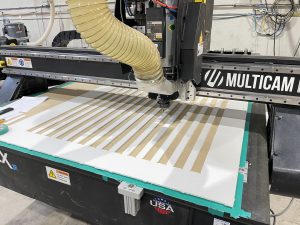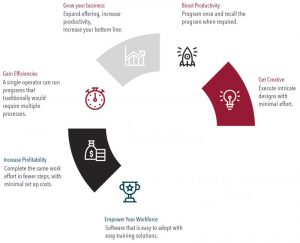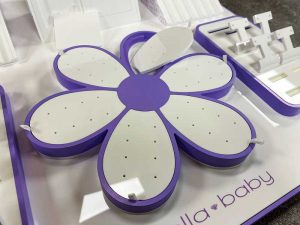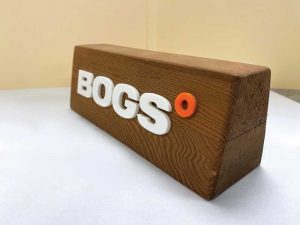Staying on the cutting edge
by carly_mchugh | 3 May 2023 12:31 pm
 [1]
[1]Advancements in computer numerical control (CNC) cutting technology have helped revolutionize the signmaking industry. Photos courtesy MultiCam Canada/Mikon Machinery
By Daniel Austin
Advancements in computer numerical control (CNC) cutting technology have helped revolutionize industries such as signmaking, woodworking, metalworking, and general fabrication. More recently, advancements in digital cutting have allowed operators to perform short-run die cutting jobs, as well as platemaking processes with flexo and corrugate materials. Signmakers who have implemented CNC routers with spindles, or with knives and camera options, are seeing gains in productivity and creativity, which can positively impact their bottom line in both the short- and long-term.
What is CNC cutting technology?
With increased accuracy and repeatability, CNC routers outfitted with spindles are ideal for creating intricate designs and shapes with precision—taking wood, aluminum, and plastic projects to the next level.
In recent years, improved tooling systems, advanced control systems, and better machine components have helped streamline cutting processes and boost automation. While new tooling systems allow for faster cutting speeds and higher accuracy by improving the cutting pressure of the tool, advanced control systems allow for more accurate cutting and greater control over the CNC router’s speed, acceleration, and deceleration. Additionally, new components such as servomotors, spindles, and bearings have been developed to improve the overall performance of the machine—thus enabling less downtime, along with higher speed and efficiency.
Benefits for the print and sign industries
CNC cutting technologies provide a consistent product, in any volume. Shops can start with a prototype, then run short or large volumes with accuracy and consistency. They can also increase their speed by running multiple production steps at the same time. The amount of labour required to run a CNC router can be reduced to a single operator running complicated projects. Since the operator does not need to handle the substrates, the machine also vastly improves the safety in operations.
Project teams can cut mixed media for display and sign fabrication with precision, using multiple materials and producing perfectly fitting pieces, allowing more creativity with design and manufacturing. From simple countertop displays to complex product presentations, and larger millwork and metal projects—including product designs that feature inlaid metal, plastic, and wood components—CNC cutting technologies can help simplify any job. Further, large runs of components and detailed wall installations can become attainable by any operator.
Digital knife cutting
For signmakers and printers working with corrugate, card stock, and foam core, a CNC router with a camera and knife cutter can greatly expand in-house capabilities for producing prototypes, short-run pieces, and flexo plates and patches. These machines are built for versatility and designed to upgrade both speed and tooling as a business grows. Printers and signmakers have the flexibility to iterate and tweak designs based on feedback, improving customer satisfaction as well as their suite of services. Shops can control the entire process in-house, from start to finish, and save cutting programs from prototype to production, to streamline efficiencies on items that are reordered in short runs.
 [2]
[2]Signmakers who have implemented CNC routers with spindles, or with knives and camera options, are seeing gains in productivity and creativity, which can positively impact their bottom line in both the short- and long-term.
Easy-to-use software
Another area of advancement in CNC cutting technology has been the development of more user-friendly software. For example, certain options allow users to create more complex designs with ease—controlling the experience from design to completion. The right software also makes it simpler to program the CNC router and set up jobs for production, as well as troubleshoot and identify potential problems with the machine.
On-board software solutions allow shops to predefine cutting settings and create profiles that will ensure accuracy when run by multiple operators. Bridging the gap between programming and fabrication makes it easier to run projects more efficiently and focus on refining production processes.
The flexibility of machine cutting can be seen in both short-run and larger projects. Compared to processes such as die cutting, savings can be seen from the onset—eliminating costly dies and allowing for a more tailored approach to design and production.
CNC machines in action
Below are a few examples of projects made using the latest CNC technology, as well as what types of tooling and techniques were utilized to create the desired effects.
 [3]
[3]Figure 1 – Bella Baby
Bella Baby
Bella Baby children’s jewellery (Figure 1) was looking to upgrade their existing display and reduce production costs, while manufacturing locally to control the quality.
Several elements and techniques came together to complete this project. Producing each component to the desired specification with a single tool allowed the team to cut the acrylic precisely and accurately, to ensure the correct assembly of multiple pieces. It also allowed them to replicate the look of injection moulding, without the additional tooling costs.
Since the display required so many complex cuts, an in-depth programming process was integral to completing it efficiently. Once this part of the process was finalized, the team selected the appropriate bit to achieve the desired thickness for each component.
For this project, they decided to use a stronger bit, which was intentionally designed for aluminum, running at a speed of 80 impressions per minute (ipm). This allowed for less vibration and higher precision when making each cut. They also used a 4.7-mm (0.18-in.) carbide bit for the lettering on the display.
 [4]
[4]Figure 2 – HiWay Cannabis
HiWay Cannabis
To support a new product launch, HiWay Cannabis (Figure 2) was looking for impactful signage that would make an impression. With several hundred pieces produced for multiple locations on the first order, creating a finished product that was economical to ship was also a key factor. Cutting with a slotted base reduced assembly time during fabrication and allowed this piece to be completed within weeks.
A multilayered logo mounted to full-colour-printed polyvinyl chloride (PVC) demanded a cut to perfect registration. Using a 4.7-mm end mill bit for the lettering helped reduce vibration and ensured better control for the operator. The base was produced with a 6.3-mm (0.25-in.) bit, to increase the longevity and durability of the signage.
BOGS
This project for BOGS (Figure 3) demonstrates a simple application which showcases an acrylic logo with multiple colours.
Since the piece was intended to be produced in high volume, BOGS was looking for something that could be replicated on demand.
 [5]
[5]Figure 3 – BOGS
Using specialized software, the team developed the most efficient layout to minimize waste, while increasing efficiency and profitability.
Although a simple design, the challenge was the size of the pieces and the thickness of the substrate. The 3.1-mm (0.12-in.) acrylic was cut with a 4.7-mm bit in one pass. The programmer worked closely with the operator to choose appropriate masking and achieve zero waste for this project.
Conclusion
Recent advancements in CNC router and knife cutting technology have greatly improved the performance and usability of the machines. With more advanced tooling systems, improved components, and user-friendly software, CNC routers and knife cutters are now more capable of producing intricate designs and shapes with greater accuracy and greater speed.
Daniel Austin is the CEO of MultiCam Canada and Mikon Machinery Group Inc. Austin is a CNC machine tool and cutting equipment professional, responsible for overseeing the sales and support of hundreds of machines operating daily. Austin has a wealth of experience in sheet cutting for sign, graphics, and display processes.
- [Image]: https://www.signmedia.ca/wp-content/uploads/2023/05/IMG-7527.jpg
- [Image]: https://www.signmedia.ca/wp-content/uploads/2023/05/cnc_Infographic.jpg
- [Image]: https://www.signmedia.ca/wp-content/uploads/2023/05/cnc_bella.jpg
- [Image]: https://www.signmedia.ca/wp-content/uploads/2023/05/cnc_IMG_9830_hiway.jpg
- [Image]: https://www.signmedia.ca/wp-content/uploads/2023/05/cnc_IMG_9834.jpg
Source URL: https://www.signmedia.ca/staying-on-the-cutting-edge/